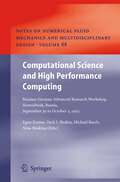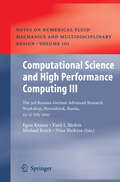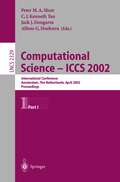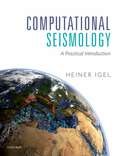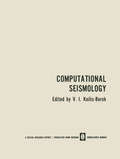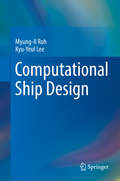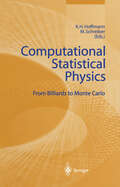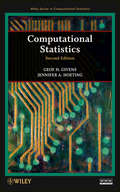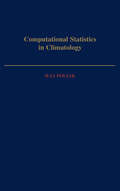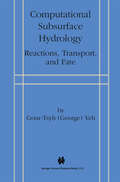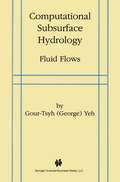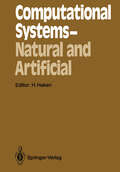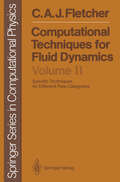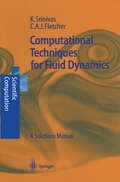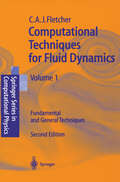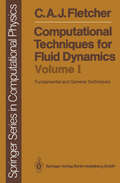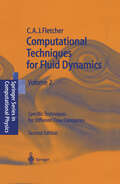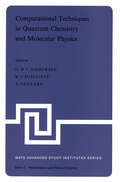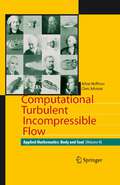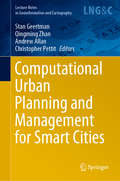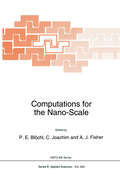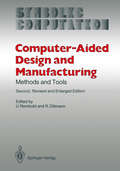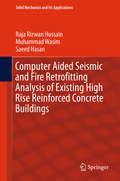- Table View
- List View
Computational Science and High Performance Computing: Russian-German Advanced Research Workshop, Novosibirsk, Russia, September 30 to October 2, 2003 (Notes on Numerical Fluid Mechanics and Multidisciplinary Design #88)
by Egon Krause Yurii I. Shokin Nina ShokinaThisvolumeispublishedastheproceedingsoftheRussian-GermanAdvanced Research workshop on Computational Science and High Performance C- puting in Novosibirsk Academgorodok in September 2003. The contributions of these proceedings were provided and edited by the authors, chosen after a careful selection and reviewing. The workshop was organized by the Institute of Computational Techno- gies SB RAS (Novosibirsk, Russia) and the High Performance Computing Center Stuttgart (Stuttgart, Germany). The objective was the discussion of the latest results in computational science and to develop a close coope- tion between Russian and German specialists in the above-mentioned ?eld. The main directions of the workshop are associated with the problems of computational hydrodynamics, application of mathematical methods to the development of new generation of materials, environment protection pr- lems, development of algorithms, software and hardware support for hi- performance computation, and designing modern facilities for visualization of computational modelling results. The importance of the workshop topics was con?rmed by the partici- tion of representatives of major research organizations engaged in the so- tion of the most complex problems of mathematical modelling, development of new algorithms, programs and key elements of new information techno- gies. Among the Russian participants were researchers of the Institutes of the Siberian Branch of the Russian Academy of Sciences: Institute of Com- tational Technologies, Institute of Computational Mathematics and Mat- matical Geophysics, Institute of Computational Modelling, Russian Federal Nuclear Center, All-Russian Research Institute of Experimental Physics, - merovo State University.
Computational Science and High Performance Computing II: The 2nd Russian-German Advanced Research Workshop, Stuttgart, Germany, March 14 to 16, 2005 (Notes on Numerical Fluid Mechanics and Multidisciplinary Design #91)
by Egon Krause Yurii I. Shokin Nina ShokinaThis volume contains 27 contributions to the Second Russian-German Advanced Research Workshop on Computational Science and High Performance Computing presented in March 2005 at Stuttgart, Germany. Contributions range from computer science, mathematics and high performance computing to applications in mechanical and aerospace engineering.
Computational Science and High Performance Computing III: The 3rd Russian-German Advanced Research Workshop, Novosibirsk, Russia, 23 - 27 July 2007 (Notes on Numerical Fluid Mechanics and Multidisciplinary Design #101)
by Egon Krause Yurii I. Shokin Nina ShokinaComputational Science - ICCS 2002: International Conference, Amsterdam, The Netherlands, April 21-24, 2002. Proceedings, Part I (Lecture Notes in Computer Science #2329)
by Peter M. A. Sloot C. J. Kenneth Tan Jack J. Dongarra Alfons G. HoekstraComputational Science is the scienti?c discipline that aims at the development and understanding of new computational methods and techniques to model and simulate complex systems. The area of application includes natural systems – such as biology, envir- mental and geo-sciences, physics, and chemistry – and synthetic systems such as electronics and ?nancial and economic systems. The discipline is a bridge b- ween ‘classical’ computer science – logic, complexity, architecture, algorithms – mathematics, and the use of computers in the aforementioned areas. The relevance for society stems from the numerous challenges that exist in the various science and engineering disciplines, which can be tackled by advances made in this ?eld. For instance new models and methods to study environmental issues like the quality of air, water, and soil, and weather and climate predictions through simulations, as well as the simulation-supported development of cars, airplanes, and medical and transport systems etc. Paraphrasing R. Kenway (R.D. Kenway, Contemporary Physics. 1994): ‘There is an important message to scientists, politicians, and industrialists: in the future science, the best industrial design and manufacture, the greatest medical progress, and the most accurate environmental monitoring and forecasting will be done by countries that most rapidly exploit the full potential ofcomputational science’. Nowadays we have access to high-end computer architectures and a large range of computing environments, mainly as a consequence of the enormous s- mulus from the various international programs on advanced computing, e.g.
Computational Seismology: A Practical Introduction
by Heiner IgelThis book is an introductory text to a range of numerical methods used today to simulate time-dependent processes in Earth science, physics, engineering, and many other fields. The physical problem of elastic wave propagation in 1D serves as a model system with which the various numerical methods are introduced and compared. The theoretical background is presented with substantial graphical material supporting the concepts. The results can be reproduced with the supplementary electronic material provided as python codes embedded in Jupyter notebooks. The book starts with a primer on the physics of elastic wave propagation, and a chapter on the fundamentals of parallel programming, computational grids, mesh generation, and hardware models. The core of the book is the presentation of numerical solutions of the wave equation with six different methods: 1) the finite-difference method; 2) the pseudospectral method (Fourier and Chebyshev); 3) the linear finite-element method; 4) the spectral-element method; 5) the finite-volume method; and 6) the discontinuous Galerkin method. Each chapter contains comprehension questions, theoretical, and programming exercises. The book closes with a discussion of domains of application and criteria for the choice of a specific numerical method, and the presentation of current challenges.
Computational Seismology
by V. I. Keilis-Boroksense do not grow as fast as computational possi This book contains selections from Volumes bilities. I-V of the series "Computational Seismology," which Moreover, for some strange reason, comput was initiated a few years ago by the Academy of ers usually create a spirit of haste, though they are Sciences of the USSR. Volume V was still in prepa intended to provide time for meditation. In com ration when the translation was begun, and the trans puterizing seismology, therefore, one must first lations of papers from it were made from manu generalize the methods and then make them more scripts. Most of the authors are members of the rigorous mathematically. All relevant data must Department of Computational Geophysics of the In be processed jointly. Insofar as is possible, a priori stitute of Physics of the Earth, Moscow. hypotheses should be avoided. Particular attention The series is dedicated to theoretical and must be given to exact formulation of the problem, computational aspects of the analysis of seismolog to questions of uniqueness and stability, to the con ical data. The present state of this field is typical fidence limits of the results, etc. This general ap of our times. The rapidly increasing flow of infor proach is required in solving the main problems of mation is already too vast to be processed or even modern seismology, which are by definition general comprehended in a traditional way. This has forced problems. This approach has other advantages.
Computational Ship Design (Springer Series On Naval Architecture, Marine Engineering, Shipbuilding And Shipping Ser. #4)
by Myung-Il Roh Kyu-Yeul LeeThis book offers an introduction to the fundamental principles and systematic methodologies employed in computational approaches to ship design. It takes a detailed approach to the description of the problem definition, related theories, mathematical formulation, algorithm selection, and other core design information. Over eight chapters and appendices the book covers the complete process of ship design, from a detailed description of design theories through to cutting-edge applications. Following an introduction to relevant terminology, the first chapters consider ship design equations and models, freeboard calculations, resistance prediction and power estimation. Subsequent chapters cover topics including propeller deign, engine selection, hull form design, structural design and outfitting. The book concludes with two chapters considering operating design and economic factors including construction costs and fuel consumption. The book reflects first-hand experiences in ship design and R&D activities, and incorporates improvements based on feedback received from many industry experts. Examples provided are based on genuine case studies in the field. The comprehensive description of each design stage presented in this book offers guidelines for academics, researchers, students, and industrial manufactures from diverse fields, including ocean engineering and mechanical engineering. From a commercial point of view the book will be of great value to those involved in designing a new vessel or improving an existing ship.
Computational Statistical Physics: From Billiards to Monte Carlo
by K. H Hoffmann Michael SchreiberIn recent years statistical physics has made significant progress as a result of advances in numerical techniques. While good textbooks exist on the general aspects of statistical physics, the numerical methods and the new developments based on large-scale computing are not usually adequately presented. In this book 16 experts describe the application of methods of statistical physics to various areas in physics such as disordered materials, quasicrystals, semiconductors, and also to other areas beyond physics, such as financial markets, game theory, evolution, and traffic planning, in which statistical physics has recently become significant. In this way the universality of the underlying concepts and methods such as fractals, random matrix theory, time series, neural networks, evolutionary algorithms, becomes clear. The topics are covered by introductory, tutorial presentations.
Computational Statistics (Wiley Series in Computational Statistics #710)
by Geof H. Givens Jennifer A. HoetingThis new edition continues to serve as a comprehensive guide to modern and classical methods of statistical computing. The book is comprised of four main parts spanning the field: Optimization Integration and Simulation Bootstrapping Density Estimation and Smoothing Within these sections,each chapter includes a comprehensive introduction and step-by-step implementation summaries to accompany the explanations of key methods. The new edition includes updated coverage and existing topics as well as new topics such as adaptive MCMC and bootstrapping for correlated data. The book website now includes comprehensive R code for the entire book. There are extensive exercises, real examples, and helpful insights about how to use the methods in practice.
Computational Statistics (Wiley Series in Computational Statistics #708)
by Geof H. Givens Jennifer A. HoetingThis new edition continues to serve as a comprehensive guide to modern and classical methods of statistical computing. The book is comprised of four main parts spanning the field: Optimization Integration and Simulation Bootstrapping Density Estimation and Smoothing Within these sections,each chapter includes a comprehensive introduction and step-by-step implementation summaries to accompany the explanations of key methods. The new edition includes updated coverage and existing topics as well as new topics such as adaptive MCMC and bootstrapping for correlated data. The book website now includes comprehensive R code for the entire book. There are extensive exercises, real examples, and helpful insights about how to use the methods in practice.
Computational Subsurface Hydrology: Reactions, Transport, and Fate
by Gour-Tsyh (George) YehAny numerical subsurface model is comprised of three components: a theoretical basis to translate our understanding phenomena into partial differential equations and boundary conditions, a numerical method to approximate these governing equations and implement the boundary conditions, and a computer implementation to generate a generic code for research as well as for practical applications. Computational Subsurface Hydrology: Reactions, Transport, and Fate is organized around these themes. The fundamental processes occurring in subsurface media are rigorously integrated into governing equations using the Reynolds transport theorem and interactions of these processes with the surrounding media are sophisticatedly cast into various types of boundary conditions using physical reasoning. A variety of numerical methods to deal with reactive chemical transport are covered in Computational Subsurface Hydrology: Reactions, Transport, and Fate with a particular emphasis on the adaptive local grid refinement and peak capture using the Lagrangian-Eulerian approach. The topics on coupled fluid flows and reactive chemical transport are unique contributions of this book. They serve as a reference for research as well as for practical applications with a computer code that can be purchased from the author. Four computer codes to simulate vertically integrated horizontal solute transport (LEMA), contaminant transport in moving phreatic aquifers in three dimensions (3DLEMA), solute transport in variably saturated flows in two dimensions (LEWASTE), and solute transport under variably saturated flows in three dimensions (3DLEWASTE) are covered. These four computer codes are designed for generic applications to both research and practical problems. They could be used to simulate most of the practical, real-world field problems. Reactive chemical transport and its coupling with fluid flows are unique features in this book. Theories, numerical implementations, and example problems of coupled reactive transport and flows in variably saturated media are presented. A generic computer code, HYDROGEOCHEM 3.0, is developed. A total of eight example problems are used to illustrate the application of the computational model. These problems are intended to serve as examples for setting up a variety of simulations that one may encounter in research and field-site applications. Computational Subsurface Hydrology: Reactions, Transport, and Fate offers practicing engineers and scientists a theoretical background, numerical methods, and computer codes for modeling contaminant transport in subsurface media. It also serves as a textbook for senior and graduate course on reactive chemical transport in subsurface media in disciplines such as civil and environmental engineering, agricultural engineering, geosciences, soil sciences, and chemical engineering. Computational Subsurface Hydrology: Reactions, Transport, and Fate presents a systematic derivation of governing equations and boundary conditions of subsurface contaminant transport as well as reaction-based geochemical and biochemical processes. It discusses a variety of numerical methods for moving sharp-front problems, expounds detail procedures of constructing Lagrangian-Eulerian finite element methods, and describes precise implementation of computer codes as they are applied to subsurface contaminant transport and biogeochemical reactions.
Computational Subsurface Hydrology: Fluid Flows
by Yeh Gour-TsyhComputational Subsurface Hydrology: Fluid Flows offers practicing engineers and scientists a theoretical background, numerical methods, and computer codes for the modeling of fluid flows in subsurface media. It will also serve as a text for senior and graduate courses on fluid flows in subsurface media in disciplines such as civil and environmental engineering, agricultural engineering, geosciences, soil sciences, and chemical engineering. Computational Subsurface Hydrology: Fluid Flows presents a systematic derivation of governing equations and boundary conditions of subsurface fluid flow. It discusses a variety of numerical methods, expounds detailed procedures for constructing finite element methods, and describes precise implementation of computer codes as they are applied to subsurface flows. Four computer codes to simulate vertically integrated horizontal flows (FEWA), saturated flows with moving phreatic surfaces in three dimensions (3DFEWA), variably saturated flows in two dimensions (FEMWATER), and variable flows in three dimensions (3DFEMWATER) are attached to this book. These four computer codes are designed for generic applications to both research and practical problems. They could be used to simulate most of the practical, real-world field problems. If you would like a copy of the diskettes containing the four, basic general purpose computer codes referred to in Computational Subsurface Hydrology: Fluid Flows, please email Gour-Tsyh Yeh at the following address : gyeh@mail.ucf.edu
Computational Systems — Natural and Artificial: Proceedings of the International Symposium on Synergetics at Schloß Elmau, Bavaria, May 4–9, 1987 (Springer Series in Synergetics #38)
by Hermann HakenThis book contains the invited papers presented at an international sympo sium held at Schloss Elmau, Bavaria (FRG), May 4-9, 1987. Leading experts from neurobiology, medicine, physics, and the computer sciences joined to gether to present and discuss their most recent results. A particular example of the natural computational systems discussed is the visual system of man and animals. A bridge between neural networks and physical systems is provided by spin glass models of neural networks, which were also treated. Concrete realizations of new kinds of devices in microelectronics were among the further topics, as were general problems on the calculation of chaotic orbits. In this way these proceedings present a number of quite recent ap proaches to problems which are of great current interest in fields concerned with computational systems. Bringing together scientists from neurobiology, physics, and the computer sciences has been one of the main aims of the synergetics enterprise, and in particular of its international symposia, from the very beginning. For exam ple, its first meeting held in 1972 at Schloss Elmau included, among others, papers by R. Landauer and J. W. F. Woo on cooperative phenomena in data processing, by W. Reichardt on mechanisms of pattern recognition by the visual system of insects, by B. Julesz on stereoscopic depth perception, and by H. R. Wilson on cooperative phenomena in a homogeneous cortical tissue model. Whole meetings and the corresponding proceedings were devoted to these problems, e. g.
Computational Techniques for Fluid Dynamics: Specific Techniques for Different Flow Categories (Springer Series in Computational Physics)
by Clive A. FletcherAs indicated in Vol. 1, the purpose of this two-volume textbook is to pro vide students of engineering, science and applied mathematics with the spe cific techniques, and the framework to develop skill in using them, that have proven effective in the various branches of computational fluid dy namics Volume 1 describes both fundamental and general techniques that are relevant to all branches of fluid flow. This volume contains specific tech niques applicable to the different categories of engineering flow behaviour, many of which are also appropriate to convective heat transfer. The contents of Vol. 2 are suitable for specialised graduate courses in the engineering computational fluid dynamics (CFD) area and are also aimed at the established research worker or practitioner who has already gained some fundamental CFD background. It is assumed that the reader is famil iar with the contents of Vol. 1. The contents of Vol. 2 are arranged in the following way: Chapter 11 de velops and discusses the equations governing fluid flow and introduces the simpler flow categories for which specific computational techniques are considered in Chaps. 14-18. Most practical problems involve computational domain boundaries that do not conveniently coincide with coordinate lines. Consequently, in Chap. 12 the governing equations are expressed in generalised curvilinear coordinates for use in arbitrary computational domains. The corresponding problem of generating an interior grid is considered in Chap. 13.
Computational Techniques for Fluid Dynamics: A Solutions Manual (Scientific Computation)
by Karkenahalli Srinivas Clive A.J. FletcherThis complementary text provides detailed solutions for the problems that appear in Chapters 2 to 18 of Computational Techniques for Fluid Dynamics (CTFD), Second Edition. Consequently there is no Chapter 1 in this solutions manual. The solutions are indicated in enough detail for the serious reader to have little difficulty in completing any intermediate steps. Many of the problems require the reader to write a computer program to obtain the solution. Tabulated data, from computer output, are included where appropriate and coding enhancements to the programs provided in CTFD are indicated in the solutions. In some instances completely new programs have been written and the listing forms part of the solution. All of the program modifications, new programs and input/output files are available on an IBM compatible floppy direct from C.A.J. Fletcher. Many of the problems are substantial enough to be considered mini-projects and the discussion is aimed as much at encouraging the reader to explore ex tensions and what-if scenarios leading to further dcvelopment as at providing neatly packaged solutions. Indeed, in order to givc the reader a better intro duction to CFD reality, not all the problems do have a "happy ending". Some suggested extensions fail; but the reasons for the failure are illuminating.
Computational Techniques for Fluid Dynamics 1: Fundamental and General Techniques (Scientific Computation)
by Clive A.J. FletcherThis well-known 2-volume textbook provides senior undergraduate and postgraduate engineers, scientists and applied mathematicians with the specific techniques, and the framework to develop skills in using the techniques in the various branches of computational fluid dynamics. A solutions manual to the exercises is in preparation.
Computational Techniques for Fluid Dynamics 1: Fundamental and General Techniques (Springer Series in Computational Physics)
by Clive A.J. FletcherThe purpose of this two-volume textbook is to provide students of engineer ing, science and applied mathematics with the specific techniques, and the framework to develop skill in using them, that have proven effective in the various branches of computational fluid dynamics (CFD). Volume 1 de scribes both fundamental and general techniques that are relevant to all branches of fluid flow. Volume 2 provides specific techniques, applicable to the different categories of engineering flow behaviour, many of which are also appropriate to convective heat transfer. An underlying theme of the text ist that the competing formulations which are suitable for computational fluid dynamics, e.g. the finite differ ence, finite element, finite volume and spectral methods, are closely related and can be interpreted as part of a unified structure. Classroom experience indicates that this approach assists, considerably, the student in acquiring a deeper understanding of the strengths and weaknesses of the alternative computational methods. Through the provision of 24 computer programs and associated exam ples and problems, the present text is also suitable for established research workers and practitioners who wish to acquire computational skills without the benefit of formal instruction. The text includes the most up-to-date techniques and is supported by more than 300 figures and 500 references.
Computational Techniques for Fluid Dynamics 2: Specific Techniques for Different Flow Categories (Scientific Computation)
by Clive A.J. FletcherThe purpose and organisation of this book are described in the preface to the first edition (1988). In preparing this edition minor changes have been made, par ticularly to Chap. 1 (Vol. 1) to keep it reasonably current, and to upgrade the treatment of specific techniques, particularly in Chaps. 12-14 and 16-18. How ever, the rest of the book (Vols. 1 and 2) has required only minor modification to clarify the presentation and to modify or replace individual problems to make them more effective. The answers to the problems are available in Solutions Manual jor Computational Techniques jor Fluid Dynamics by K. Srinivas and C. A. J. Fletcher, published by Springer-Verlag, Heidelberg, 1991. The computer programs have also been reviewed and tidied up. These are available on an IBM compatible floppy disc direct from the author. I would like to take this opportunity to thank the many readers for their usually generous comments about the first edition and particularly those readers who went to the trouble of drawing specific errors to my attention. In this revised edi tion considerable effort has been made to remove a number of minor errors that had found their way into the original. I express the hope that no errors remain but welcome communication that will help me improve future editions. In preparing this revised edition I have received considerable help from Dr. K.
Computational Techniques in Quantum Chemistry and Molecular Physics: Proceedings of the NATO Advanced Study Institute held at Ramsau, Germany, 4–21 September, 1974 (Nato Science Series C: #15)
by Geerd H. F. Diercksen B. T. Sutcliffe A. VeillardThis book contains the transcripts of the lectures presented at the NATO Advanced study Institute on "Computational Techniques in Quantum Chemistry and Molecular Physics", held at Ramsau, Germany, 4th - 21st Sept. 1974. Quantum theory was developed in the early decades of this century and was first applied to problems in chemistry and molecular physics as early as 1927. It soon emerged however, that it was impossible to con sider any but the simplest systems in any quantita tive detail because of the complexity of Schrodinger's equation which is the basic equation for chemical and molecular physics applications. This remained the si tuation until the development, after 1950, of elec tronic digital computers. It then became possible to attempt approximate solutions of Schrodinger's equa tion for fairly complicated systems, to yield results which were sufficiently accurate to make comparison with experiment meaningful. Starting in the early nineteen sixties in the United States at a few centres with access to good computers an enormous amount of work went into the development and implementation of schemes for approximate solu tions of Schrodinger's equation, particularly the de velopment of the Hartree-Fock self-consistent-field scheme. But it was soon found that the integrals needed for application of the methods to molecular problems are far from trivial to evaluate and cannot be easily approximated.
Computational Turbulent Incompressible Flow: Applied Mathematics: Body and Soul 4
by Johan Hoffman Claes JohnsonThis is Volume 4 of the book series of the Body and Soul mathematics education reform program. It presents a unified new approach to computational simulation of turbulent flow starting from the general basis of calculus and linear algebra of Vol 1-3. The book puts the Body and Soul computational finite element methodology in the form of General Galerkin (G2) up against the challenge of computing turbulent solutions of the inviscid Euler equations and the Navier-Stokes equations with small viscosity. This is an outstanding textbook presenting plenty of new material with an excellent pedagogical approach.
Computational Urban Planning and Management for Smart Cities (Lecture Notes in Geoinformation and Cartography)
by Stan Geertman Andrew Allan Qingming Zhan Christopher PettitThis book contains a selection of the best articles presented at the CUPUM (Computational Urban Planning and Urban Management) conference, held in the second week of July 2019 at the University of Wuhan, China. The chapters included were selected based on a double-blind review process involving external reviewers.
Computations for the Nano-Scale (NATO Science Series E: #240)
by P. E. Blöchl C. Joachim A. J. FisherProceedings of the NATO Advanced Research Workshop, Aspet, France, October 12-16, 1992
Computer-Aided Design and Manufacturing: Methods and Tools (Symbolic Computation)
by U. Rembold R. DillmannManufacturing contributes to over 60 % of the gross national product of the highly industrialized nations of Europe. The advances in mechanization and automation in manufacturing of international competitors are seriously challenging the market position of the European countries in different areas. Thus it becomes necessary to increase significantly the productivity of European industry. This has prompted many governments to support the development of new automation resources. Good engineers are also needed to develop the required automation tools and to apply these to manufacturing. It is the purpose ofthis book to discuss new research results in manufacturing with engineers who face the challenge of building tomor row's factories. Early automation efforts were centered around mechanical gear-and-cam technology and hardwired electrical control circuits. Because of the decreasing life cycle of most new products and the enormous model diversification, factories cannot be automated efficiently any more by these conventional technologies. With the digital computer, its fast calculation speed and large memory capacity, a new tool was created which can substantially improve the productivity of manufactur ing processes. The computer can directly control production and quality assurance functions and adapt itself quickly to changing customer orders and new products.
Computer Aided Seismic and Fire Retrofitting Analysis of Existing High Rise Reinforced Concrete Buildings (Solid Mechanics and Its Applications #222)
by Raja Rizwan Hussain Muhammad Wasim Saeed HasanThis book details the analysis and design of high rise buildings for gravity and seismic analysis. It provides the knowledge structural engineers need to retrofit existing structures in order to meet safety requirements and better prevent potential damage from such disasters as earthquakes and fires.Coverage includes actual case studies of existing buildings, reviews of current knowledge for damages and their mitigation, protective design technologies, and analytical and computational techniques. This monograph also provides an experimental investigation on the properties of fiber reinforced concrete that consists of natural fibres like coconut coir and also steel fibres that are used for comparison in both Normal Strength Concrete (NSC) and High Strength Concrete (HSC). In addition, the authors examine the use of various repair techniques for damaged high rise buildings. The book will help upcoming structural design engineers learn the computer aided analysis and design of real existing high rise buildings by using ACI code for application of the gravity loads, UBC- 97 for seismic analysis and retrofitting analysis by computer models. It will be of immense use to the student community, academicians, consultants and practicing professional engineers and scientists involved in the planning, design, execution, inspection and supervision for the proper retrofitting of buildings.
